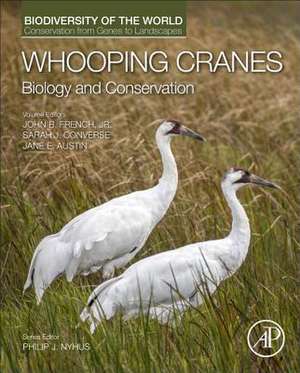Whooping Cranes: Biology and Conservation: Biodiversity of the World: Conservation from Genes to Landscapes: Biodiversity of the World: Conservation from Genes to Landscapes
Philip J. Nyhus John B French, Sarah J. Converse, Jane E. Austinen Limba Engleză Hardback – 11 oct 2018
This edited volume concentrates on work completed in the past 20 years in the areas of population biology, behavior and social structure, habitat use, disease and health, captive breeding, and Whooping Crane conservation. Much of the information presented comes from the study and management of remnant and reintroduced populations of Whooping Cranes in the field; some information is from experimentation and breeding of captive Whooping Cranes.
Whooping Cranes: Biology and Conservation seeks to inform and galvanize action dedicated to meeting the challenges faced by Whooping Crane managers and conservationists. Thus, it describes one model of endangered species conservation and restoration that will interest a wide audience: professionals that work on cranes; researchers in the fields of small population biology, endangered species, and avian ecology; wildlife veterinarians and those involved in avian husbandry; administrators of management agencies or conservation organizations; conservationists in other fields; teachers of conservation biology or ornithology and their students; and the educated general public.
- Presents a comprehensive treatment of the biology and ecology of Whooping Cranes, including biology of both remnant and reintroduced populations of Whooping Cranes
- Describes efforts over the past 45 years on conservation and the challenges of reintroducing an endangered species
- Includes chapters from a variety of disciplinary and scale perspectives, ranging from evolution, to population ecology, behavior, habitat use, large landscape conservation, conflict, and conservation efforts
- Features contributions that are readable, yet technically complete and fully referenced
- Provides an example of partnership and collegial action that integrates information produced by scientific research and operational wildlife management
- Edited and written by the leading Whooping Crane scholars and practitioners focused on this high-profile species of conservation concern
Preț: 486.08 lei
Preț vechi: 642.45 lei
-24% Nou
Puncte Express: 729
Preț estimativ în valută:
93.04€ • 95.88$ • 78.54£
93.04€ • 95.88$ • 78.54£
Carte tipărită la comandă
Livrare economică 24 februarie-10 martie
Preluare comenzi: 021 569.72.76
Specificații
ISBN-13: 9780128035559
ISBN-10: 0128035552
Pagini: 538
Dimensiuni: 191 x 235 x 28 mm
Greutate: 1.32 kg
Editura: ELSEVIER SCIENCE
Seria Biodiversity of the World: Conservation from Genes to Landscapes
ISBN-10: 0128035552
Pagini: 538
Dimensiuni: 191 x 235 x 28 mm
Greutate: 1.32 kg
Editura: ELSEVIER SCIENCE
Seria Biodiversity of the World: Conservation from Genes to Landscapes
Public țintă
Professionals who work on cranes, including researchers in the fields of small population biology, endangered species, conservation, genetic management, avian breeding biology, wildlife veterinarians, captive breeding, habitat management, those involved in husbandry; administrators of management agencies or NGOs; conservationists in other fields; teachers of Conservation Biology or Ornithology and their students; and scholars, practitioners, decision-makers, students, and individuals interested in understanding the complex challenges and opportunities to conserving and restoring the world’s biological diversityCuprins
1. Whooping Cranes Past and Present
2. Phylogenetic Taxonomy of Cranes and the Evolutionary Origin of the Whooping Crane
3. Revisiting the Historic Distribution and Habitats of the Whooping Crane
4. Population and Breeding Range Dynamics in the Aransas-Wood Buffalo Whooping Crane Population
5. Monitoring Recruitment and Abundance of the Aransas-Wood Buffalo Population of Whooping Cranes: 1950–2015
6. Mortality in Aransas-Wood Buffalo Whooping Cranes: Timing, Location, and Causes
7. Population Dynamics of Reintroduced Whooping Cranes
8. Reproductive Failure in the Eastern Migratory Population: The Interaction of Research and Management
9. Florida’s Nonmigratory Whooping Cranes
10. Pairing Dynamics of Reintroduced Migratory Whooping Cranes
11. Movement Ecology of Reintroduced Migratory Whooping Cranes
12. Ecological Energetics of Whooping Cranes in the Eastern Migratory Population
13. Winter Habitat Ecology, Use, and Availability for the Aransas wood Buffalo Population of Whooping Cranes
14. Habitat Use by the Reintroduced Eastern Migratory Population of Whooping Cranes
15. Ecological Implications of Habitat Use by Reintroduced and Remnant Whooping Crane Populations
16. Advances in Conservation Breeding and Management of Whooping Cranes (Grus americana)
17. Reproduction and Reproductive Strategies Relevant to Management of Whooping Cranes Ex Situ
18. Health of Whooping Cranes in the Central Flyway
19. Health and Disease Treatment in Captive and Reintroduced Whooping Cranes
20. Rearing and Release Methods for Reintroduction of Captive-Reared Whooping Cranes
21. The Operation of an Aircraft-led Migration: Goals, Successes, Challenges 2001-2015
22. Louisiana Non-migratory Whooping Crane Reintroduction
23. Whooping Crane Shootings since 1967
24. Future of Whooping Crane Conservation and Science
2. Phylogenetic Taxonomy of Cranes and the Evolutionary Origin of the Whooping Crane
3. Revisiting the Historic Distribution and Habitats of the Whooping Crane
4. Population and Breeding Range Dynamics in the Aransas-Wood Buffalo Whooping Crane Population
5. Monitoring Recruitment and Abundance of the Aransas-Wood Buffalo Population of Whooping Cranes: 1950–2015
6. Mortality in Aransas-Wood Buffalo Whooping Cranes: Timing, Location, and Causes
7. Population Dynamics of Reintroduced Whooping Cranes
8. Reproductive Failure in the Eastern Migratory Population: The Interaction of Research and Management
9. Florida’s Nonmigratory Whooping Cranes
10. Pairing Dynamics of Reintroduced Migratory Whooping Cranes
11. Movement Ecology of Reintroduced Migratory Whooping Cranes
12. Ecological Energetics of Whooping Cranes in the Eastern Migratory Population
13. Winter Habitat Ecology, Use, and Availability for the Aransas wood Buffalo Population of Whooping Cranes
14. Habitat Use by the Reintroduced Eastern Migratory Population of Whooping Cranes
15. Ecological Implications of Habitat Use by Reintroduced and Remnant Whooping Crane Populations
16. Advances in Conservation Breeding and Management of Whooping Cranes (Grus americana)
17. Reproduction and Reproductive Strategies Relevant to Management of Whooping Cranes Ex Situ
18. Health of Whooping Cranes in the Central Flyway
19. Health and Disease Treatment in Captive and Reintroduced Whooping Cranes
20. Rearing and Release Methods for Reintroduction of Captive-Reared Whooping Cranes
21. The Operation of an Aircraft-led Migration: Goals, Successes, Challenges 2001-2015
22. Louisiana Non-migratory Whooping Crane Reintroduction
23. Whooping Crane Shootings since 1967
24. Future of Whooping Crane Conservation and Science






